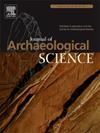In search of draught cattle: An identification method
IF 2.6
1区 地球科学
Q1 ANTHROPOLOGY
引用次数: 0
Abstract
Draught cattle, used for ploughing and carting, contributed to drive social transformations in prehistoric societies by replacing or complementing human power. However, identifying draught cattle from archaeological sites has proven challenging due to the dearth of direct evidence. This paper presents a biometric approach to identifying draught cattle in archaeological assemblages based on metapodials, and first and second phalanges. The analysis includes over 150 modern non-draught cattle encompassing various species and breeds, along with a smaller group of draught cattle. Statistical tests and multivariate analyses were first adopted, revealing distinct morphological differences between the two groups, which do not appear to be highly correlated with age. Although cattle limb bone morphology could vary between breeds, the principal component analysis suggests traction is the predominant factor distinguishing between modern draught and non-draught cattle. Biometric data from metapodials and phalanges were then applied to construct five predictive logistic regression models, with the first phalanges showing the highest balanced accuracy for separating the draught and non-draught groups, a clear advance from Lin et al. (2016)'s pioneering work. The predictive models were then applied to data from two British sites to demonstrate the applicability of the proposed approach to archaeological assemblages. The results show that this biometric approach has the potential to significantly enhance our understanding of draught cattle exploitation in the past.
寻找役畜:一种识别方法
用于犁地和拉车的役用牛,通过取代或补充人力,推动了史前社会的社会变革。然而,由于缺乏直接证据,从考古遗址中识别役畜已被证明具有挑战性。本文提出了一种基于准跖骨、第一和第二指骨的生物识别方法来识别考古组合中的役畜。该分析包括150多头现代非役用牛,包括各种品种和品种,以及一小群役用牛。首先采用统计测试和多变量分析,揭示了两组之间明显的形态差异,这似乎与年龄没有高度相关。虽然不同品种的牛肢骨形态可能不同,但主成分分析表明牵引力是区分现代役畜和非役畜的主要因素。然后,将来自跖骨和指骨的生物特征数据用于构建五个预测逻辑回归模型,其中第一个指骨在区分干旱和非干旱组方面显示出最高的平衡精度,这是Lin等人(2016)开创性工作的明显进步。然后将预测模型应用于两个英国遗址的数据,以证明所提出的方法对考古组合的适用性。结果表明,这种生物识别方法有可能显著提高我们对过去役畜剥削的理解。
本文章由计算机程序翻译,如有差异,请以英文原文为准。
求助全文
约1分钟内获得全文
求助全文
来源期刊

Journal of Archaeological Science
地学-地球科学综合
CiteScore
6.10
自引率
7.10%
发文量
112
审稿时长
49 days
期刊介绍:
The Journal of Archaeological Science is aimed at archaeologists and scientists with particular interests in advancing the development and application of scientific techniques and methodologies to all areas of archaeology. This established monthly journal publishes focus articles, original research papers and major review articles, of wide archaeological significance. The journal provides an international forum for archaeologists and scientists from widely different scientific backgrounds who share a common interest in developing and applying scientific methods to inform major debates through improving the quality and reliability of scientific information derived from archaeological research.
 求助内容:
求助内容: 应助结果提醒方式:
应助结果提醒方式:


